- Retour accueil
- Vous êtes ici : Blog The Pyramids of the Cold v2 The Pyramids of the Cold v2 • Summary of the study and Table of Contents
The Pyramids of the Cold v2 • Summary of the study and Table of Contents
Publié par Bruno Coursol dans The Pyramids of the Cold v2 le 13/05/2023 à 19:30

The Great Pyramid of Giza, the Pyramid of Khafre and the sphinx. Color lithograph by G.W. Seitz, ca. 1878, after Carl Werner, 1870: https://wellcomecollection.org/works/exnpzjwc/images?id=x3jjcet6
The Pyramids of the Cold v2 (May-July 2023) • Summary & Table of contents
0.01 Religion is the first master key to decipher the ancient Egyptian civilization
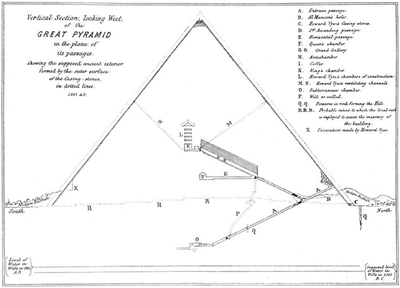
When I started working on the Great Pyramid, a little more than two years ago in January 2021, I would never have imagined in my wildest dreams I would be able to decipher so much of the ancient Egyptian civilization; but here it is, and it is both extraordinary and beautiful.
I'm pretty sure many people already know that the academic vision of ancient Egypt is somehow phoney, that there is something wrong about how are depicted the ancient Egyptians today; and I really hope egyptologists themselves don't believe a word of the "big picture" they are presenting to us since the early 1800s, a period of History which has been totally influenced by modern colonialism: ancient Egyptians simply couldn't have been unsophisticated people farming the land, and only obsessed by a stifling religion, worshiping over 2,000 gods and goddesses.
0.02 The legitimacy to reign because of scientific knowledge
Hidden behind the academic vision of the ancient Egyptian religion, a vast number of metaphors are describing some of the most advanced scientific and technological knowledge of that time: ancient Egyptian gods were nothing else than pharaohs' metaphoric self-glorifications of their theoretical and experimental scientific accomplishments in physics and chemistry.
Most probably, pharaohs used the power of science, physics and chemistry to legitimate themselves as kings of Egypt: they've forged an entire religion, based on science to rule their kingdom, and they would have presented that science as Magic.
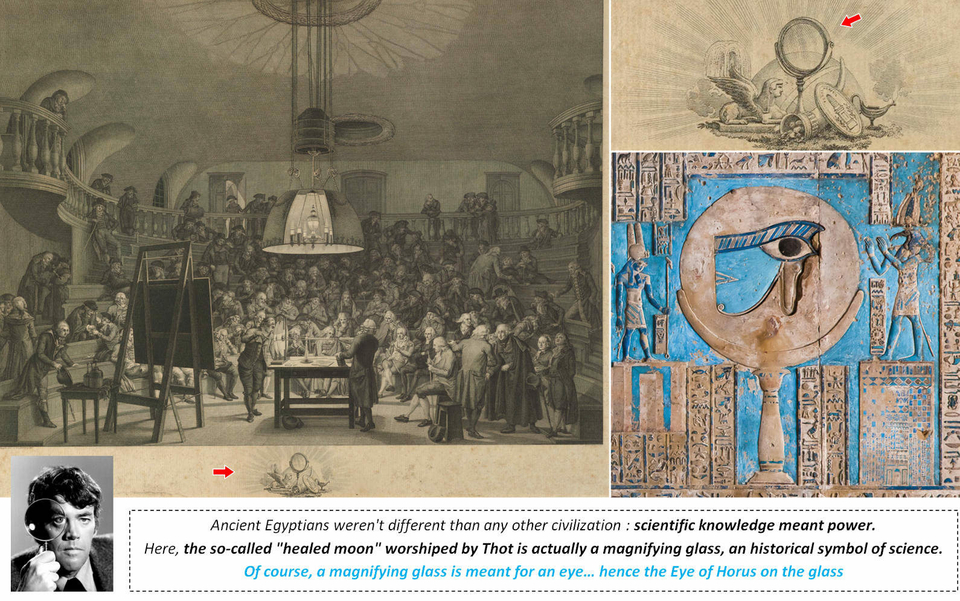
Jim Hutton as detective Ellery Queen, posing with a magnifying glass, courtesy of NBC Television: https://en.wikipedia.org/wiki/Magnifying_glass#/media/File:Jim_Hutton_Ellery_Queen_1976.JPG
0.03 God of Science Thoth and the magnifying glass
Make no mistake here, even if some parts of the study are still partially or totally unclear on some details or major items; even if some parts will be corrected or invalidated in a few months, in a few years or decades, what I am describing is what really was the ancient Egyptian civilization, 4500 years ago, while in the western world we were still playing with rocks and mud.
The big secret of ancient Egypt is indeed religion; because you cannot have more than 2,000 gods and goddesses involved in a very complex and vivid mythology if it is not somehow coordinated. Of course, the coordinators were the pharaohs themselves; Pharaohs were the ones responsible for this extremely elaborate construction, and they used myths and deities to glorify what human beings are pursuing since our species appeared on the planet: scientific and technological knowledge.
If ancient Egyptians worshiped over 2000 deities, it is only because each and every one of them have been literally crafted as scientific and technological propaganda glorifications of what really have been given the legitimacy to reign to the pharaohs.
This quest of scientific knowledge, that is precisely the meaning of the famous scene representing god of Science Thoth, worshiping "the Moon" as claimed by the academic consensus; because this is not the Moon Thoth is worshiping, but the ultimate symbol of Science: a magnifying glass. Of course, a magnifying glass is meant for an eye; hence the Eye of Horus on the glass.
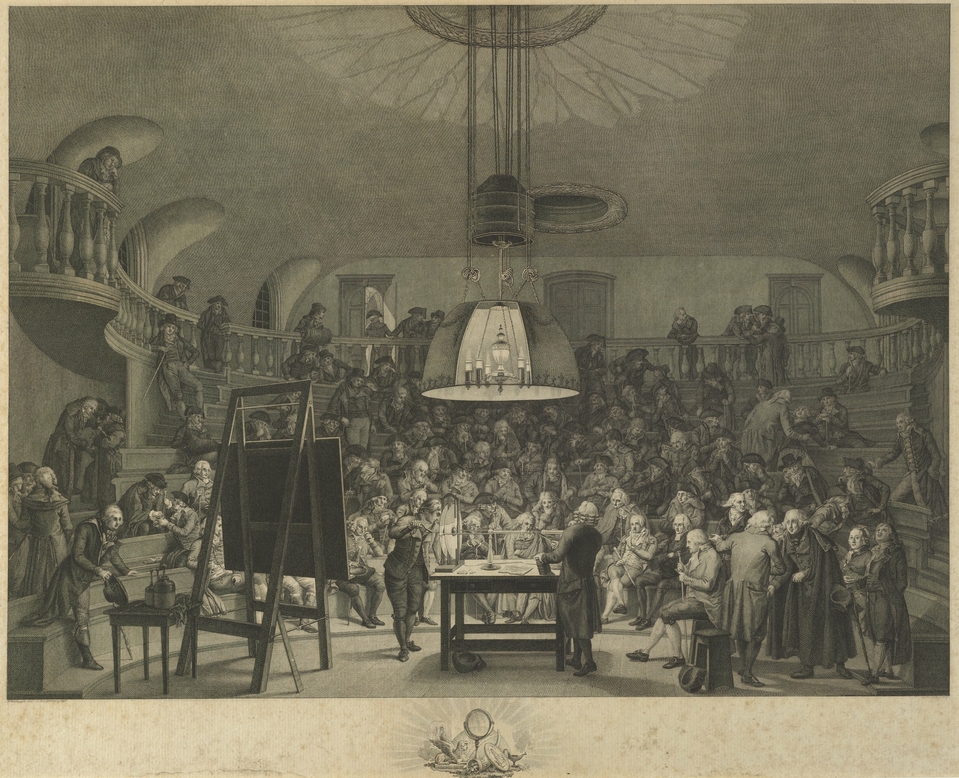
"This engraving shows Dutch mathematician and physicist Jean Henri van Swinden (1746–1823) demonstrating the generation of electricity to the Felix Meritis Society in Amsterdam. The Felix Meritis Society was founded in the late 18th century to promote the arts and sciences (Felix Meritis translates as "Happiness through Merit")". Barbiers, Pieter Pietersz., and Jacques Kuyper. Laid paper, 1800–1899. Science History Institute, Philadelphia U.S.A.: https://digital.sciencehistory.org/works/zg64tm573
0.04 A typical demonstration of Science in the 1800s at Amsterdam
I've used this image many times, but what I want to point out here, is how good is the analogy between this perfect illustration of demonstrating science in the 1800s, compared to the illustration of Thoth in the Dendera "temple"; they are not just similar, they are exactly the same: Thoth is demonstrating his knowledge in science through the magnifying glass, and towards all the other gods assembled in front of him, just like Dutch mathematician and physicist Jean Henri van Swinden is demonstrating the generation of electricity to the Felix Meritis Society in Amsterdam.
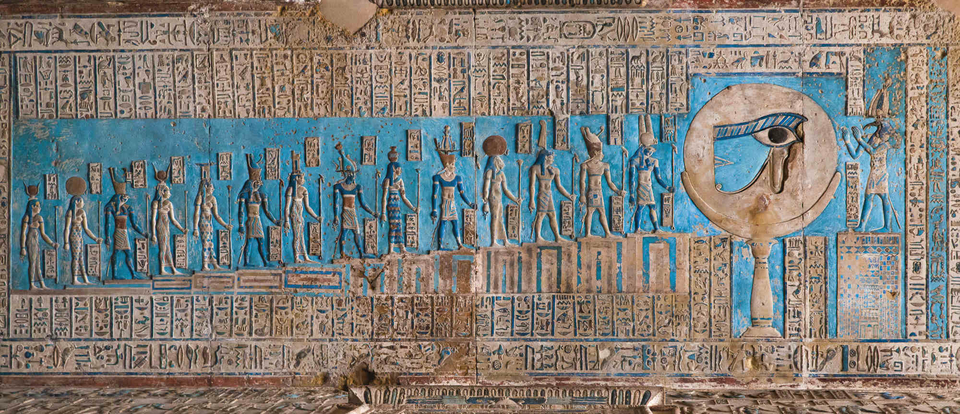
"The astronomical ceiling at the Pronaos, outer hypostyle hall in the Temple of Hathor in the Dendera Temple complex, near Dendera, Egypt: first Band west from the centre, showing the full healed moon on a pillar depicted as "Wadjet" the Eye of Horus healed by Thoth, who is portrayed at the right." Thanks to kairoinfo4u: https://www.flickr.com/photos/manna4u/9295311496
0.05 A demonstration of Science in ancient Egypt at Denderah... and also (probably) the god creation process itself
If I'm suggesting the idea that this scene representing Thoth and the magnifying glass at Dendera, could also be about the very creation process of these gods, it is only because of the way the magnifying glass is used looks so much as if it also was a kind of projector.
It does really look like Thoth is creating the gods right before our very eyes; and don't forget: Thoth isn't just the god of Science, he is also the god of Writing; Thoth just may be "writing" or "creating" the gods (the metaphors really), just under our very eyes.
0.06 Is the Egyptian Blue pigment the glorification of pure and chemically manufactured Natron?
For those who've already read the previous Sections of the study, you know that my big concern now is to know if the creation of the cold was a "simple" scientific demonstration or if it was created to cool down chemical manufacturing of sodium carbonate "natron" by a Solvay-like process; except for the representation of a Djed pillar receiving the Dendera Light, suggesting the cold would have been used for a Solvay tower, I found nothing else that would confirm this Solvay hypothesis.
But I just found out that the famous blue color, the "Egyptian blue" as we call it, was actually made with natron; so it is possible that the proof of the Solvay process is right under our own very eyes, and it is literally everywhere. It is possible that Ancient Egyptians didn't try to hide the Solvay process, but that they were actually showing it everywhere: the Egyptian blue could be the glorification of the Solvay process I was looking for so long.
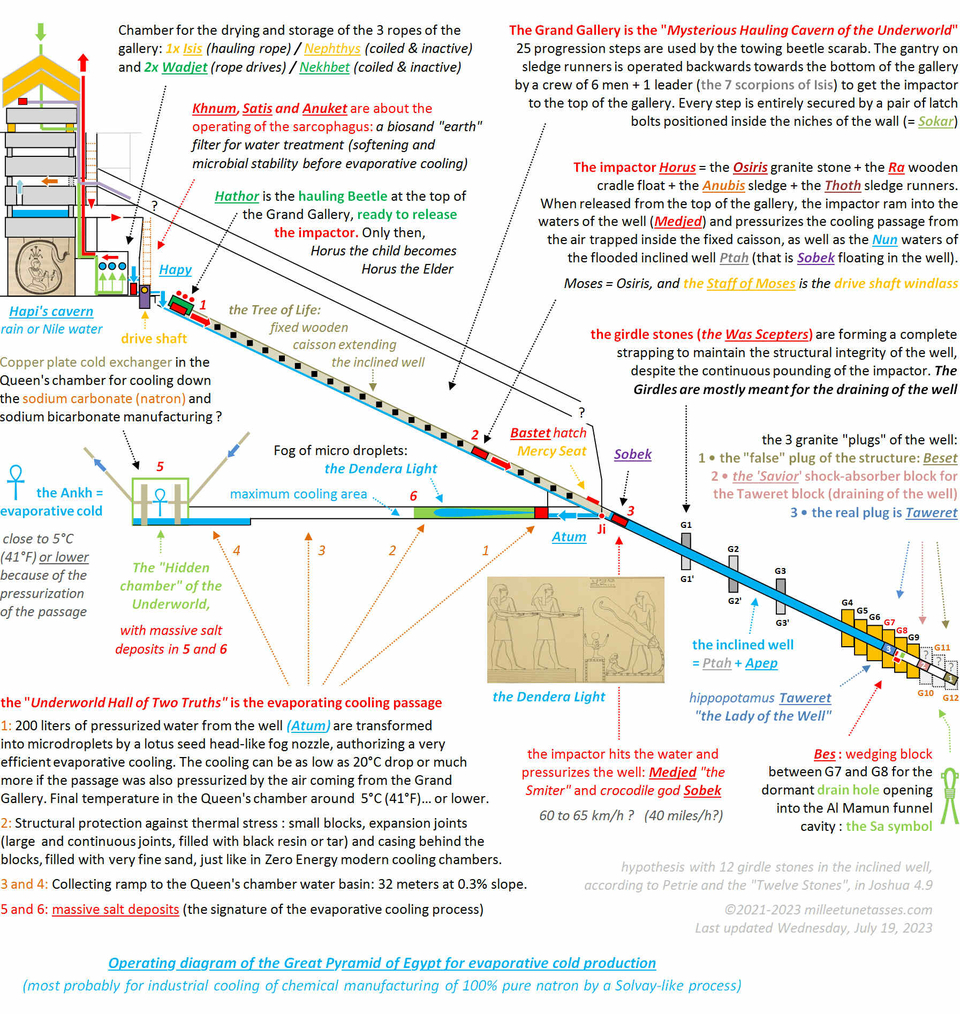
Diagram of the operating Great Pyramid of Egypt for evaporative cold production (hypothetically for chemical manufacturing cooling of pure sodium carbonate "natron", the salt used for the mummification of pharaohs). When in operation, the elevation of the Great Pyramid was not finished, and it is only after the shutdown procedure and the draining of the inclined well, that the 3 granite plugs were finally close to one another.
0.07 The operating cycle of the Great Pyramid of Egypt, for evaporative cold production and (hypothetically) for cooling down chemical manufacturing of sodium carbonate "natron" by a Solvay-like process. Last updated April 22, 2024
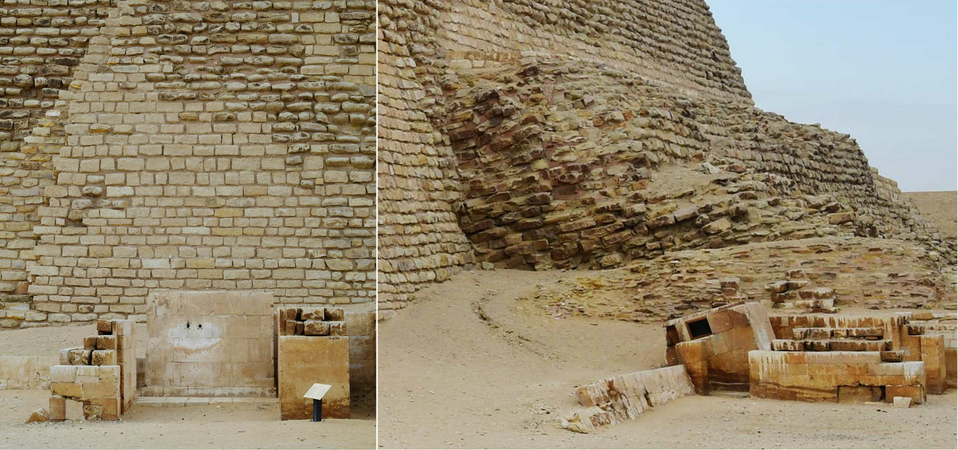
"The Pyramid Complex of Djoser (مجمع هرم زوسر) or Step Pyramid (kbhw-ntrw in Egyptian) Complex (مجمع الهرم المدرج) is an archeological site in the Saqqara necropolis, Egypt, northwest of the city of Memphis. Djoser was King of Upper and Lower Egypt in ca. 2680 BCE. Djoser was a king early in the 3rd dynasty. The construction and development of the pyramid complex is generally attributed to the architect Imhotep." https://madainproject.com/pyramid_complex_of_djoser. Photograph of Djoser's Serdab at Saqqara, by orientalizing: https://www.flickr.com/photos/orientalizing/51913885911/in/photostream/
0.08 The "cooling saga" from Djoser's Heat Pipe Serdab to the evaporative cooling of Khufu's Great Pyramid

Will see that the Red Pyramid of Sneferu (the first king of the Fourth Dynasty of ancient Egypt), had been used in its early stage of construction, to chemically produce sodium carbonate, the purest form of natron (the salt used for mummification), using a Solvay-like process and a limestone kiln set in the so-called "burial chamber"); and will see as well that if there is a huge ammonia smell in the Red Pyramid it most certainly is because of a lack of efficient temperature control.
In the (unfinished) Red Pyramid, ancient Egyptians couldn't cool down the Solvay chambers and the ammonia accumulated; this is why Khufu (the second pharaoh of the Fourth Dynasty) built the Great Pyramid to create evaporative cold.
Temperature control is the key of chemical manufacturing today and it most certainly was the main problem ancient Egyptians had to face in their own time, during the Fourth Dynasty (Sneferu and Khufu), the Third Dynasty (Djoser) and way before that.
If the Great Pyramid is the first attempt to master evaporative cold, Djoser' Serdab is the illustration of how ancient Egyptians used to deal with overheating chemical manufacturing before that.
Even if it is no secret that "Serdab" literally means "cold water", no one is using this information; and even if it is no secret that Djoser' Step Pyramid complex was referred to as the "Refreshment of the Gods" complex, no one is using this information either. But if you add these two informations about Djoser' Serdab and the fact that this Serdab was a very small sealed off chamber, only communicating with the exterior though two holes, then you can start seeing what could have been the first "active" cooling chamber of the ancient times.
Probably the Serdab was the cooling chamber (where occurred condensation of the fluid passing though the pipe) of an ancient heat pipe coming from the interior of the Step Pyramid (where occurred evaporation of the fluid passing though the pipe).
"Of course, Imhotep is most famous as the builder of Djoser’s unprecedented step pyramid complex, called "The Refreshment of the Gods." https://arce.org/resource/search-imhotep-tomb-architect-turned-god-remains-mystery/
"A serdab (Persian: سرداب), literally meaning "cold water", which became a loanword in Arabic for 'cellar' is an ancient Egyptian tomb structure that served as a chamber for the Ka statue of a deceased individual. Used during the Old Kingdom, the serdab was a sealed chamber with a small slit or hole to allow the soul of the deceased to move about freely. These holes also let in the smells of the offerings presented to the statue."
"The term serdab is also used for a type of undecorated chamber found in many pyramids. Due to the lack of inscriptions, it has been impossible to determine the ritual function of this chamber, but many Egyptologists view it as a storage space, akin with the underground storehouses in private and royal tombs of the Second Dynasty." https://en.wikipedia.org/wiki/Serdab
Heat Pipe diagram from "Development of a simplified heat pipe numerical model and case study/experimental validation using a long ‘wicked’ heat pipe": https://onlinelibrary.wiley.com/doi/abs/10.1002/er.1044
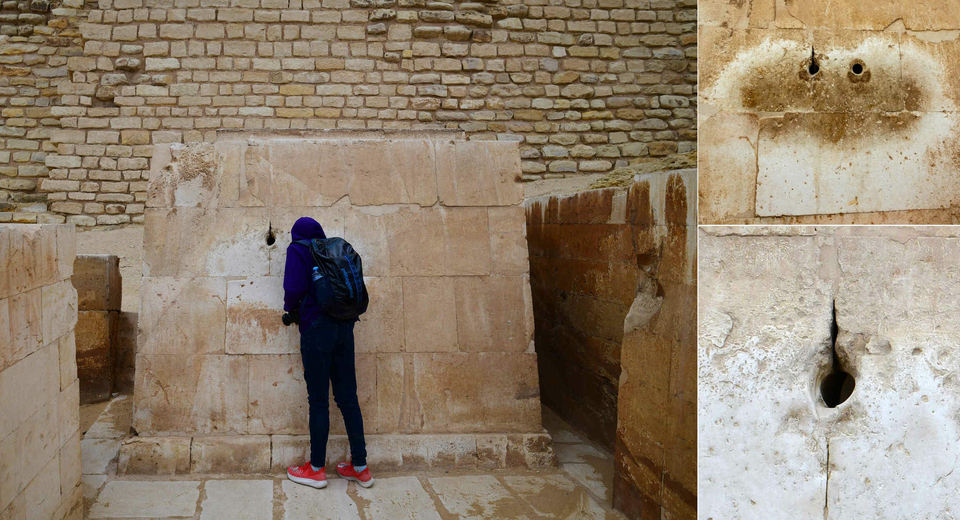
It certainly is no accident if one of the two holes in the northern wall of Djoser' Serdab is located right on the joint between two blocks: very hot (or very cold) fluid passing through a pipe wouldn't damage the structure. The joint here would be an expansion joint.
It certainly is no accident either if the entire Serdab structure is tilted as well (see the above heat pipe diagram).
0.09 One of the main difficulties of the study is to dig under "ancient beliefs" and "modern interpretations"
Because Djoser' Serdab was in direct contact with the Step Pyramid, it is fair to assume it was a fully operational cooling chamber, most probably operated like a modern passive heat pipe of some sort; there wasn't any statue in the Serdab at the time, only water and the end of the heat pipe.
The question is to know who put the statue of Djoser in the Serdab, and when did that happened?
The idea that the two holes were used so that the statue could look outside the Serdab, breathe, smell burning incense and look at the stars is both cute and depressing if anyone really believed this; but it allows me to raise another issue about ancient Egypt, and it is about the multilayer coat of beliefs that accumulated over time.
I see three origins of these layers of beliefs:
• the ancient Egyptians from the four first Dynasties, involved in the "Scientific Era" of ancient Egypt and who created gods, goddesses and myths as glorifying representations
• the ancient Egyptians who came after the Fourth Dynasty and who probably added more layers
• the egyptologists of the 19th century who tried to figure it all out, but with very little information available to them
"To the east of the temple is the serdab ("celler"), which is a small enclosed structure that housed the ka statue. The king's ka inhabited the ka statue, in order to benefit from daily ceremonies like the opening of the mouth, a ceremony that allowed him to breathe and eat, and the burning of incense. He witnessed these ceremonies through two small eye holes cut in the north wall of the serdab. The serdab was a sealed off room in a tomb containing a statue of the deceased was placed. These statues were vessels that the souls could inhibit. Djoser's serdab is located on the northern side of the Step Pyramid, in front of an open court dedicated to it. A statue depicting the king wearing the "Sed" festival robe was discovered inside. Just as the Step Pyramid is the oldest ancient Egyptian monumental stone structure, so is this statue, the first large stone statue known. The original is currently in the Egyptian Museum. The northern wall of the tilted chamber has two holes allowing the king to gaze through and see the rituals and festivals taking place in the court before him. According to the ancient beliefs the holes also allowed the king to look north, the cardinal point towards which his entire pyramid complex is oriented. This is the location of the circumpolar stars in the northern sky, his ancestors, whom he hoped to join. These stars never set below the horizon, which was seen as a sign of immortality. Djoser was thus poised to join his forefathers in everlasting life." https://madainproject.com/pyramid_complex_of_djoser
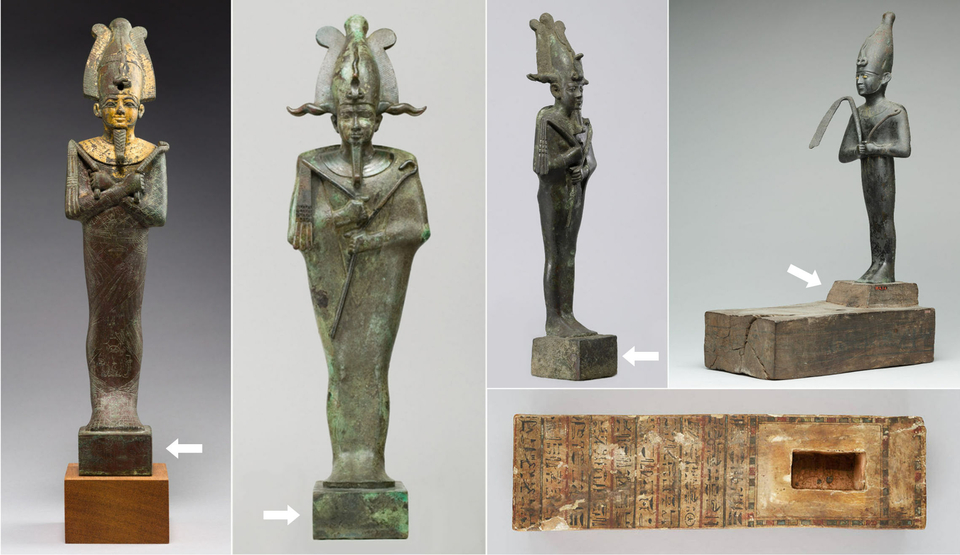
Statuette of Osiris Late Period ca. 588–526 B.C. at the MET: https://www.metmuseum.org/art/collection/search/546747
Statuette of Osiris" Late Period 664–332 B.C. at the Metropolitan Museum of Art, New-York: https://www.metmuseum.org/art/collection/search/545802
Figure of Osiris at the Walters Art Museum, Baltimore MD: https://art.thewalters.org/detail/36613/statue-of-osiris/
Osiris offered by the Astronomer of the House of Amun, Ibeb. Third Intermediate Period, ca. 1070–712 B.C. at the MET: https://www.metmuseum.org/art/collection/search/547898
Wooden base of a Ptah-Sokar-Osiris figure at the MET, dedicated to a temple musician named Ihet; it is inscribed with offering prayers and texts glorifying the gods: https://www.metmuseum.org/art/collection/search/553823
0.10 The perfect example of the deification process: the Osiris stone
To illustrate the basic concept of the ancient Egyptian scientific and technological glorification process, Osiris is the perfect example. We'll see in the next Sections that the Great Pyramid served to create evaporative cold in the so-called horizontal passage, using pressurized water resulting from the endless operation of a composite impactor, made out of both wood (the "vessel") and stone, probably a granite stone, and which has been deified into Osiris.
Osiris is the deification of the stone which gave all its power, all its force and energy to Ra, the wooden part of the impactor; and this is why many figures of Osiris are depicting him standing onto a simple "block".
Egyptologists will mention the crook and flail that Osiris is holding on these figures, or the horns, but they never talk about the most important part of the figure: the "block" on which is standing Osiris, is Osiris himself, the Osiris stone.
The ram's horns of the Osiris figures are all about the ramming force of the Osiris stone.
We'll see that this encrypting process, resulting of the association of a deity in human form and what really is representing the deity, is something that has been used many times, and really is the second master key for the real understanding of ancient Egypt.
Read the Osiris myth deciphering in Section 46 "the two magical Eyes of Isis" (Osiris 'forced' into a wooden coffin, then thrown into water before the coffin becomes 'prisonner' of a hollowed tree trunk and hauled out of water by Isis).
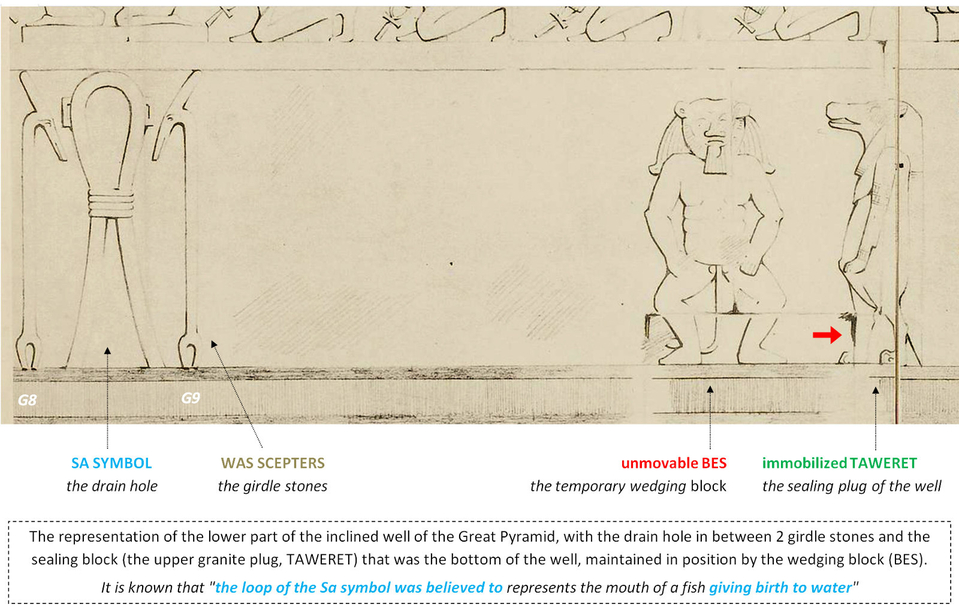
It is important to understand that during the entire operation of the Great Pyramid, hence the creation of the evaporative cold, the bottom of the inclined well was what is now known as the upper granite plug. That crucial block has been deified into the goddess Taweret and was like suspended in mid-air, blocked by a smaller granite block set in the floor of the ascending passage: the wedging block that was deified into the deity Bes.
Hatshepsut’s birth scene, from Édouard Naville "The Temple of Deir el Bahari" (London, 1896), vol. 2, pl. 50. Image courtesy of the University Library Heidelberg: The Ebony shrine, northern half of the middle platform. https://digi.ub.uni-heidelberg.de/diglit/naville1896bd2/0050
0.11 Every single part of the operation of the Great Pyramid has been glorified and deified
If Osiris is the glorification of the impactor's weight, other block of stones have been deified, such as Taweret (the upper granite plug of the Great Pyramid which was the sealing block of the inclined well) and Bes (the wedging block anchored in the floor of the ascending passage and which maintained Taweret in position during the entire operating time of the Pyramid, before its draining).
The thing is that every single part of the operating Great Pyramid has been glorified: blocks of stone, ropes, wooden equipment such as the central wooden caisson of the Grand Gallery, but also air (Shu, Sekhmet, Seth) and of course water (Hapi, Hapy, Apep, Atum…).
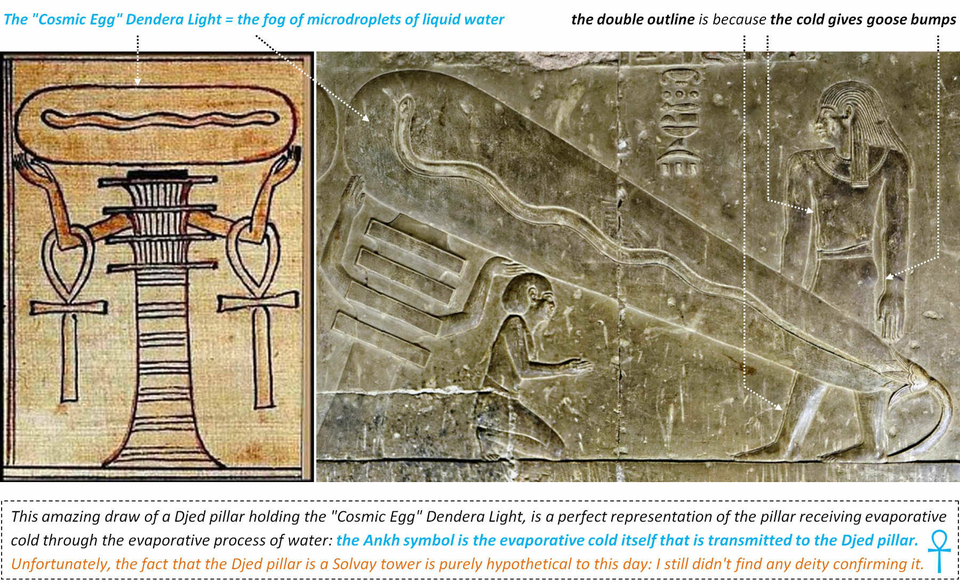
Dendera Light, thanks to kairoinfo4u: https://www.flickr.com/photos/manna4u/14525094039/in/photostream/
0.12 The Solvay process hypothesis for chemical manufacturing of 100% pure Natron
The end game of the ancient Egyptian scientific and technological program, that probably started on the very first Dynasty, was the Great Pyramid of Giza where evaporative cooling was engineered in the known part of the pyramid.
The evaporative cold simply took advantage of the power of water, and was most probably necessary to cool down chemical manufacturing of sodium carbonate and sodium bicarbonate produced by an ammonia-soda Solvay process, as strongly suggested by the very strong ammonia smell and the limestone kiln in the so-called burial chamber of the Red Pyramid.
It is important to note, that as of today, I still didn't find any certain and strong evidence of that part of the study: no god and no goddess to glorify it; the only thing that would support the idea is the above image of a Djed pillar receiving the evaporative cold (the Dendera light-like shape).
At that time, sodium carbonate was called natron, and it was the salt used for the mummification of the pharaohs.
The cooling seems to have represented the most difficult part of the process, as suggested by the Step Pyramid's official name : according to scholars, the very first pyramid complex, the Step Pyramid of Djoser, was called "the refreshment of the Gods". No doubt that a more accurate translation would certainly be "the cooling of the Gods".
If this part is correct, it would mean that ancient Egyptians were the first civilization to master a Solvay-like process for sodium carbonate manufacturing, long before it got reinvented in the 1800's in Europe. The key elements of that process is the temperature control of the chemical reactions (the cooling), and the dome shaped plate necessary for the counterflow chemical reactions to occur in an efficient way. That counterflow reaction plate is what really is the disc of Sabu.
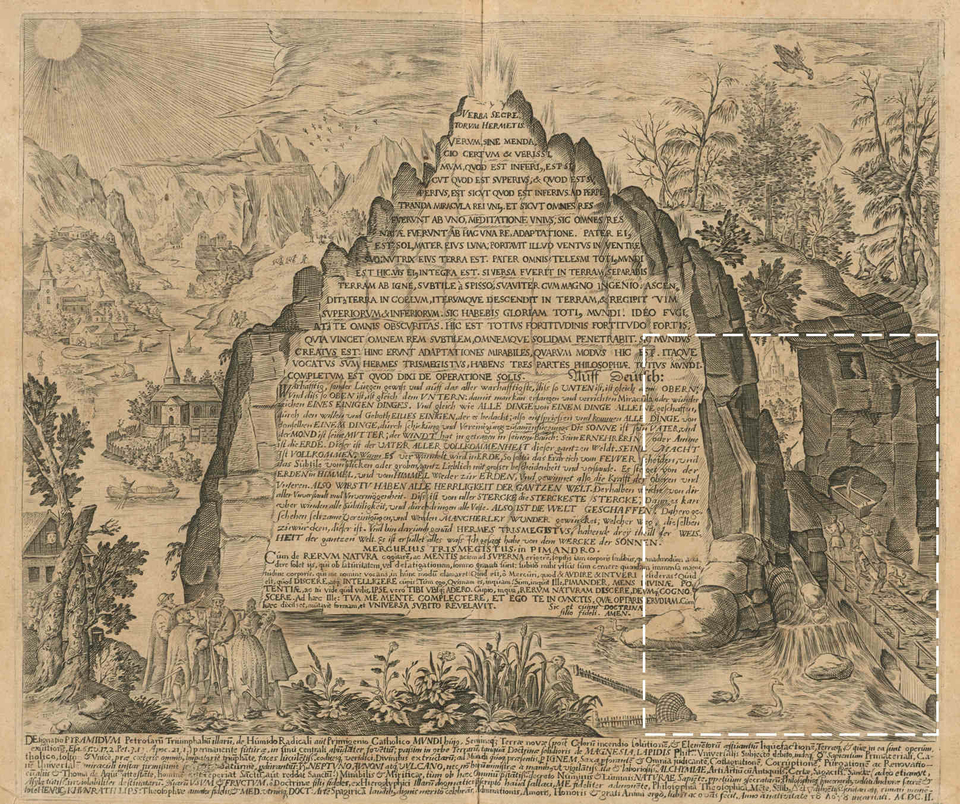
Illustration of the Hermetica: an imaginative 17th-century depiction of the Emerald Tablet from the work of Heinrich Khunrath (1560-1605), 1606: https://en.wikipedia.org/wiki/Emerald_Tablet
0.13 The tremendous impact of the Great Pyramid on the entire ancient World
Probably the most unexpected finding of this study is not about Egypt itself, but rather about the extraordinary impact that the Great Pyramid (its operation and its glorification) had on other civilizations. The "Churning of the Ocean" Hindu myth that produces the immortal nectar Amrita, the Tibetan Prayer Wheels operated to give small amounts of 'merit' to too lazy Naga snakes, the entire Norse mythology with Thor's magical hammer endlessly fighting another Great Serpent of the Underworld and producing a mist of cold from a mysterious well that would be opposed to hellishly hot heat waves, or the traditional Maori ceremonial dance Haka: they've all been totally influenced by the Great Pyramid.
But the most incredible illustration of the tremendous impact that the Great Pyramid had other the entire ancient World, is coming from the Emerald tablet, an artifact from the late 1500s or early 1600s in which both the operation of the Great Pyramid and the draining of the inclined well had been unequivocally represented.
"The Emerald Tablet, also known as the Smaragdine Tablet or the Tabula Smaragdina (Latin, from the Arabic: Lawḥ al-zumurrudh), is a compact and cryptic Hermetic text. It was highly regarded by Islamic and European alchemists as the foundation of their art. Though attributed to the legendary Hellenistic figure Hermes Trismegistus, the text of the Emerald Tablet first appears in a number of early medieval Arabic sources, the oldest of which dates to the late eighth or early ninth century. It was translated into Latin several times in the twelfth and thirteenth centuries. Numerous interpretations and commentaries followed." https://en.wikipedia.org/wiki/Emerald_Tablet

Vertical section, looking West, of the Great Pyramid of Giza, in the plane of its passages, by Manly Palmer Hall : https://commons.wikimedia.org/wiki/File:The_Secret_Teaching_of_All_Ages_-_Chapter_6_-_Pyramid.jpg
The Pyramids of the Cold v2 (May 2023) • Table of contents
The starting point of the deciphering of the Great Pyramid is in the so-called horizontal passage; it is there I first found the very first key leading to the evaporative cold process; and from there, we'll literally have to track back the water flow upstream towards the Upper part of the Pyramid with the biosand filter sarcophagus and the King's chamber main water tank.
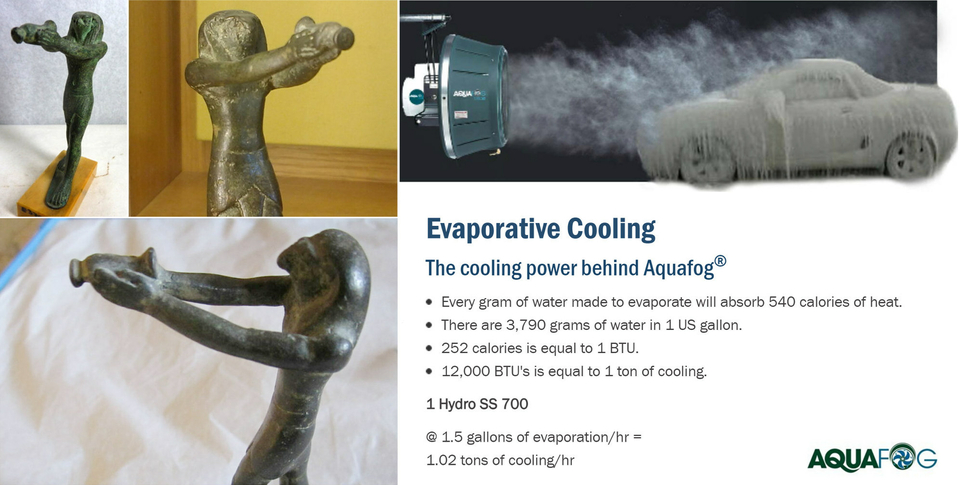
Evaporative cooling applications of AquaFog® webpage screenshot from Jaybird Manufacturing Inc (Pennsylvania, USA): https://jaybird-mfg.com/applications/evaporative-cooling/
The Pyramids of the Cold v2 (May 2023) • Part A: the horizontal evaporative cooling passage of the Great Pyramid
Section 1 • The horizontal evaporative cooling passage layout
Section 2 • The Dendera Light and the creation of the fog of microdroplets by the fog nozzle
Section 3 • The water cycle glorifying metaphors: Geb, Shu, Nut, Tefnut
Section 4 • The theorization of the evaporative cooling process by Akhenaten and Nefertiti
Section 5 • The theorization of the evaporative cooling process in the Weighing of the Heart
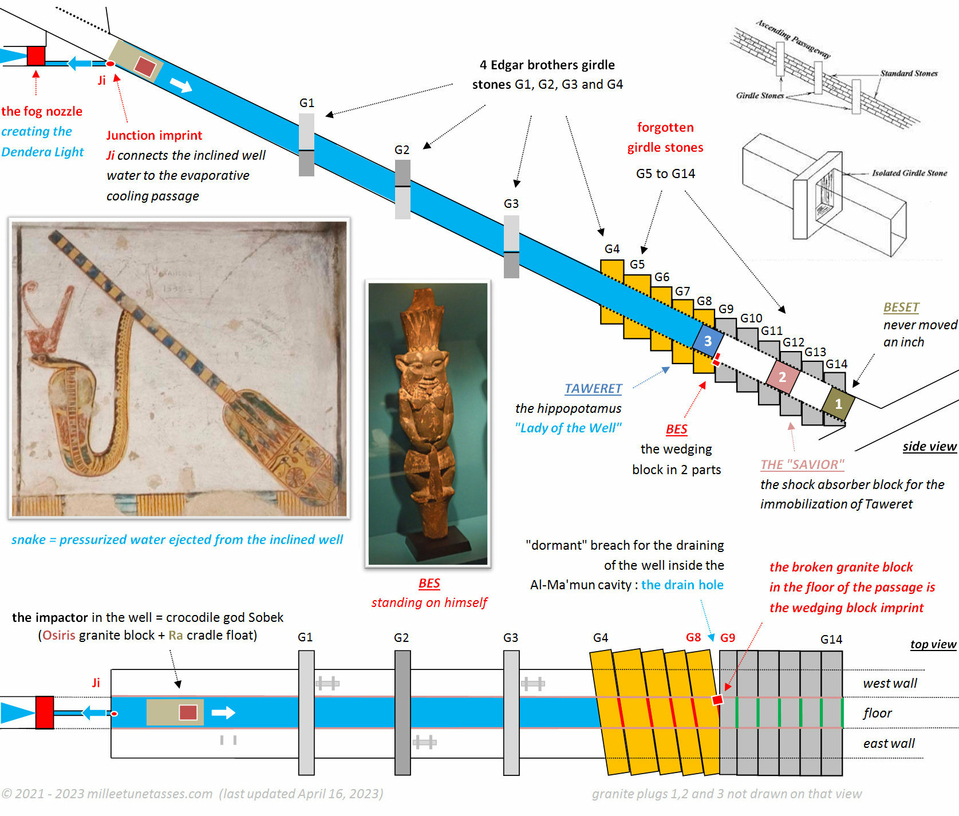
The Pyramids of the Cold v2 (May 2023) • Part B: the inclined well of the Great Pyramid of Giza
Section 6 • The inclined well layout and the girdle stones
Section 7 • The Taweret "Lady of the Well" temporary sealing granite plug of the well
Section 8 • The Bes temporary wedging block immobilizing Taweret
Section 9 • The draining of the well
Section 10 • The Great Serpent Apep and the snake water metaphors
Section 11 • The Was scepter and the control over "snakes"
Section 12 • The beating Heart of the Great Pyramid
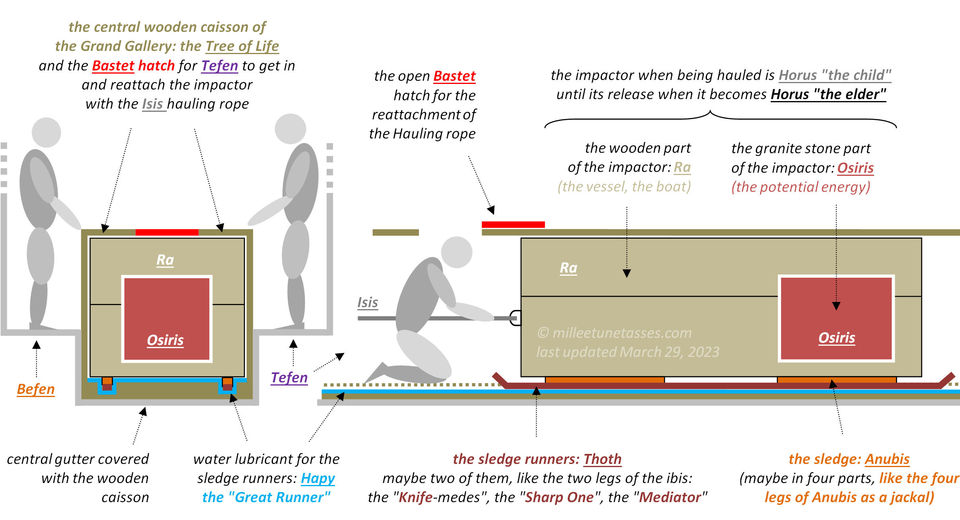
The Pyramids of the Cold v2 (May 2023) • Part C: the impactor of the Great Pyramid of Giza
Section 13 • The wooden and stone composite design of the impactor: Ra and Osiris
Section 14 • The endlessly immersed Osiris stone and the seed metaphor
Section 15 • The Anubis sledge and the bobsled mask
Section 16 • The sledge runners of the impactor: Thoth
Section 17 • Medjed: the smiter nobody can ever see
Section 18 • The Apis bull and the ramming impactor's metaphors
Section 19 • The crocodile god Sobek impactor (more or less) floating in the waters of the well
Section 20 • The Obelisk and the Benben stone rising from water
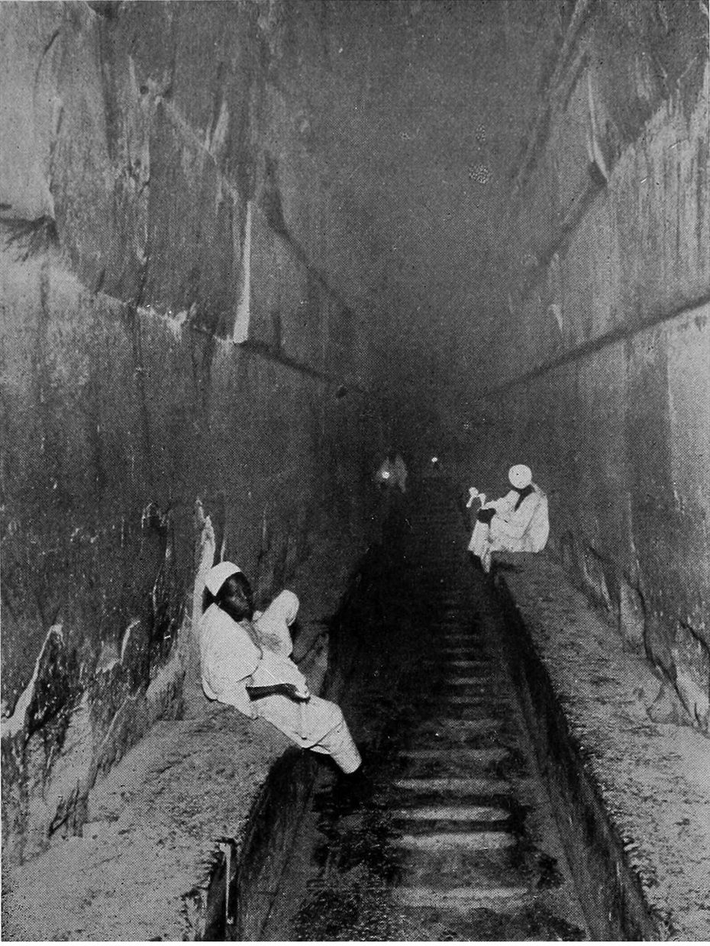
Original image of the Grand Gallery of the Great Pyramid of Egypt at Giza, built by pharaoh Khufu, from page 52 of "The call of the stars; a popular introduction to a knowledge of the starry skies with their romance and legend" (1919) by Kippax, John R. (John Robert), 1849-1922: https://www.flickr.com/photos/internetarchivebookimages/14597229618/
The Pyramids of the Cold v2 (May 2023) • Part D: the Grand Gallery's of the Great Pyramid of Giza
Section 21 • The Sacred "sloping paths" of the "oval-shaped cavern of the act of Hauling"
Section 22 • The central wooden caisson of the Gallery: Sekhmet and the Triad of Memphis
Section 23 • The hauling ropes of the Grand Gallery: Isis, Nephthys, Hatmehit, Wadjet and Nekhbet
Section 24 • The hauling Beetle and the Seven Scorpions of Isis
Section 25 • The Great Cow goddess Hathor and the operating cycle of the hauling Beetle
Section 26 • The 10 operating phases of the Grand Gallery
Section 27 • The guide to the Afterlife for the smart traveler and the canopic jars
Section 28 • The scarab amulet glorifications of the hauling Beetle
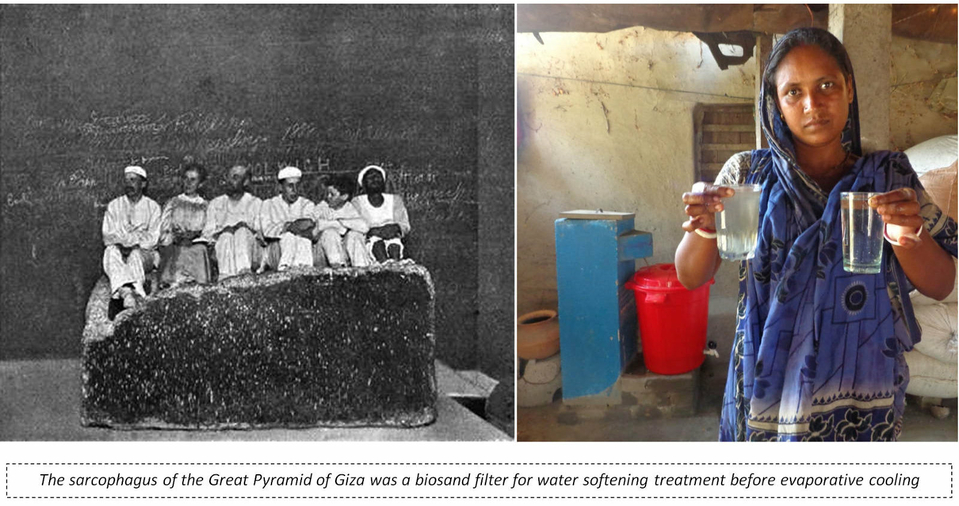
The sarcophagus of the Great Pyramid of Giza was the "mold" of an ancient Egyptian biosand water filter. "How to make a wooden mold for biosand water filters", by Rob Goodier at https://www.engineeringforchange.org/news/how-to-make-a-wooden-mold-for-biosand-water-filters/
The Pyramids of the Cold v2 (May 2023) • Part E: the very large and roughly finished sarcophagus of the Great Pyramid
Section 29 • The biosand filter sarcophagus of the Great Pyramid
Section 30 • The Elephantine Triad deification of the biosand filter of the Great Pyramid
Section 31 • The Great Pyramid's operating flat roof and the water supply issue
The Pyramids of the Cold v2 (May 2023) • Part F: Chemical manufacturing and industrial cooling before the Great Pyramid
Section 32 • The Serdab and the "Refreshment of the Gods" Step Pyramid of Djoser
Section 33 • Sneferu's Red Pyramid and the accumulated ammonia
Section 34 • The Disc of Sabu and the Solvay process for pure natron manufacturing
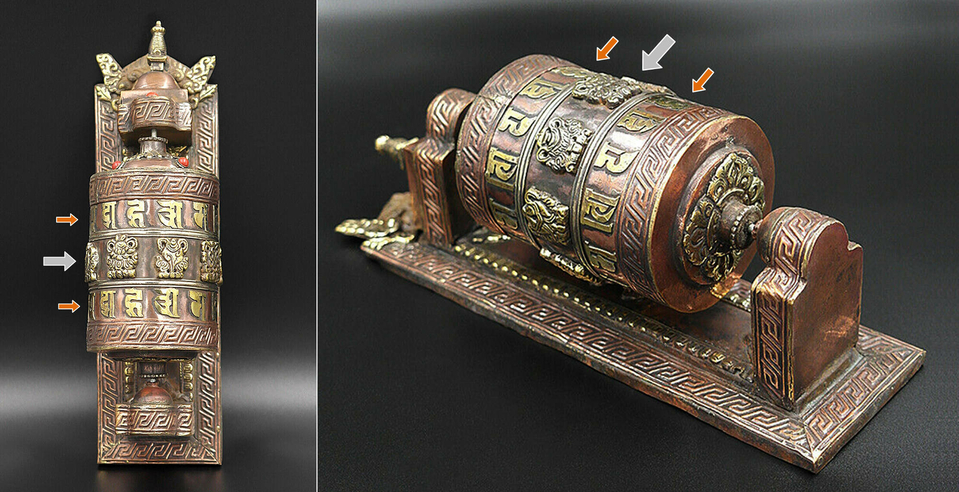
The "wall mounted" Tibetan prayer wheels were of course supposed to be fixed on the floor, not on the wall: they are the perfect reproduction of the axle beam shaft of the Grand Gallery. The 3 ropes are even perfectly depicted.
"Copper wall mounted prayer wheel with Om mane peme hum mantra in Newari (Ranjana) lipi. The Buddhist stupa in the top of the prayer wheel makes this as nice religious home décor. This handmade prayer wheel can be placed on the wall in your prayer room, meditation room or in the living room. The prayer wheel is filled with a mantra roll printed with the compassion mantra of Chenrezig, Om Mani Padme Hum. This prayer wheel is handmade in Nepal. The prayer wheel has 2 lines Om Mani Mantra Tibetan Mantra and 1 line Auspicious Symbol in the center. Worshippers turn prayer wheels to accumulate merit, to help all beings in the world and to purify their karma (intentional actions). They are part of a meditation."
"The prayer wheel should be turned clockwise with a single-pointed concentration of body, speech, and mind. It is easy and fast to turn the prayer wheel and it does not require great physical strength or many repetitions." https://vajracrafts.com/products/buddhist-copper-prayer-wheel-with-wall-mount
The Pyramids of the Cold v2 (May 2023) • Part G: the impact of the Great Pyramid on foreign civilizations
Section 35 • The hidden secrets of the Hermetica Emerald Tablet (around 1600 C.E.)
Section 36 • Thor and the magical Hammer in the Great Hall of Bilskirnir
Section 37 • The Churning of the waters of the Ocean of Milk (Hindu mythology)
Section 38 • The Tibetan prayer wheels and the Grand Gallery's operation
Section 39 and Conclusion • The cooling water of spitting Kebechet
Part H • Epilogue
Section 40 • The smiting Ark of the Covenant and the Ten Commandments
Section 41 • The 293 kilograms windlass Staff of Moses... and the First Plague of Egypt: water turning into blood
Section 42 • Ezekiel's Four Egyptian pulley "Wheels within the Wheels" and the four angel ropes
Section 43 • David, Saul, two giant Goliaths, five little stones, an aeolian harp... and a weaver's beam
Section 44 • The holy water fonts and the biosand filter
Part I • The magicians of the Great Pyramid of Giza
Section 45 • The Legend of Khufu and the "magician" polymath Imhotep
Section 46 • The two magical eyes of Isis and the brilliant but painful flame of her twin sister's braids
Section 47 • The Aegis Shield of Athena "Subduer of the Winds" and the upper hatch of the central wooden caisson
Section 48 • The Seven Magical Words spoken by 'Divine Sealer' Goddess of Arrows and Bronze Neith
Section 49 • When the Taweret plug finally moves and becomes Mother of Fire Opet: the sparkling rocks metaphor
Section 50 • The sledge, the wet grooved rail and the Colossus
In memory of Pratt, beloved companion who just died, July 1st 2024, 11h00 a.m. I love you Pratt, I miss you so much...
Sagi
Hi,
as I've mentioned several times, the early parts of the study are absolutely brilliant, you've cracked the matter, you've hacked the enigma.
However, last few articles are repeating themselves.
You should check for references proving other parts of the puzzle.
Indeed sodium carbonate as the main product is starting to be questionable...
Poster un commentaire
